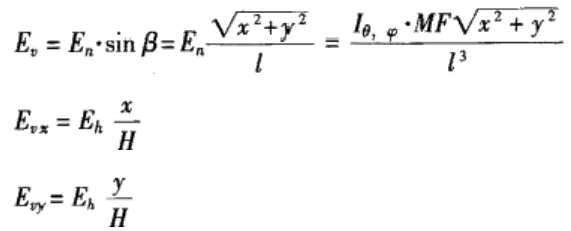Tennis Court Lighting Regulation: Glare,Layout,Poles Height,Lux Levels,Calculation
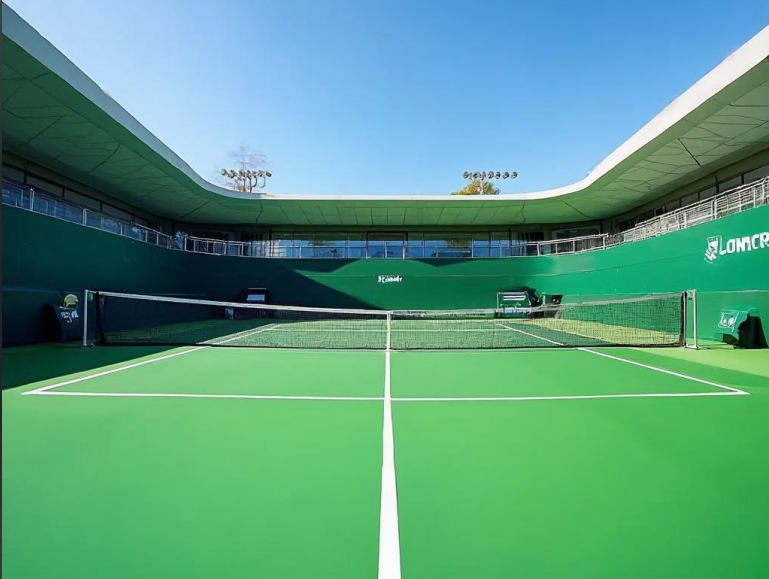
Directory:
1. Tennis Court Measurements
2. Tennis Court Lighting Requirements
3. Tennis Court Lighting Layout
4. Tennis Court Lighting Calculation
1. Tennis Court Measurements
A tennis court consists of two parallel sidelines and two parallel baselines that form a rectangular space. If the ball lands outside this area during a match, it is considered out of bounds. This designated area is known as the Principal Playing Area (PPA). However, players have a larger range of movement than just the PPA during a match, which is referred to as the Total Playing Area (TPA). The dimensions of the TPA can vary slightly depending on the standards of different tennis courts. For specific measurements, refer to Figure 1.
Figure 1: Tennis Court Dimensions
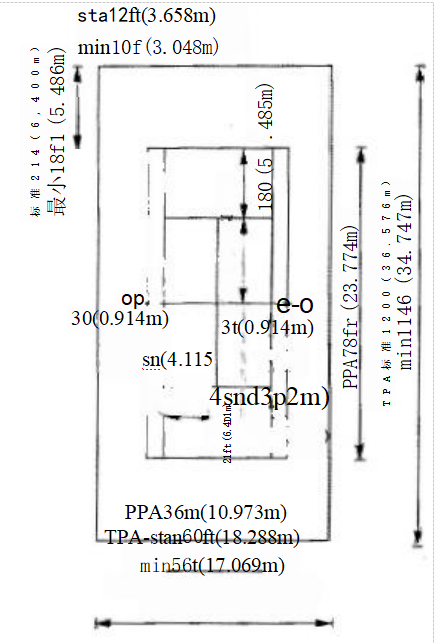
2. Tennis Court Lighting Requirements
Different sports and levels of competition have specific lighting standards. Since indirect light is challenging to quantify, these standards focus on direct light and do not factor in natural daylight. The lighting must not only allow players to see the speed and direction of the ball for quick reactions but also ensure high-quality visuals for athletes, referees, and spectators during television broadcasts, which raises the lighting requirements.
For tennis courts, key measurements for lighting quality include horizontal illuminance (EA), vertical illuminance (E), illuminance uniformity (U₁, U₂), glare value (GR), relevant color temperature (Tp), and color rendering index (Ra).
2.1 Horizontal Illuminance (Eh)
When a light source illuminates a point on the horizontal plane, the vertical illuminance at that point is equivalent to the horizontal illuminance. The horizontal illuminance, denoted as Eh, primarily influences how well the eyes can see.
In general, athletes are positioned close together in the stadium, so a lower level of illuminance is sufficient for their needs during the game. In contrast, the audience is seated further away and in more dispersed locations, making it essential for the illuminance to be adequate for clear visibility.
For international events or competitions that are televised, there are typically only recommended values for vertical illuminance. This is because if the vertical illuminance meets the required standards, the horizontal illuminance will also be sufficient, and the horizontal illuminance can be derived from the vertical illuminance measurements.
Tab.1 Recommendation value of horizontal illuminance of the tennis court

2.2 Vertical Illumination E
On the horizontal plane, vertical illuminance (E) is defined as the illuminance that includes the illuminated point and is perpendicular to the horizontal illuminance. This vertical illuminance plays a significant role in enhancing the three-dimensional perception of an object.
In contrast to horizontal illuminance, there are numerous vertical planes, leading to countless directions of vertical illuminance. For television broadcasts, a stationary camera only needs vertical illuminance at a suitable angle relative to the lens to fulfill its requirements, while a moving camera must ensure that vertical illuminance is adequate across all side views.
Similar to horizontal illuminance, vertical illuminance must not only satisfy the needs of TV broadcasts but also meet the visual requirements of athletes and spectators for tracking moving objects or balls on the field.
2.3 Uniformity of Illumination
As players navigate the TPA, it is essential to maintain consistent horizontal and vertical lighting levels to prevent excessive visual contrast and misinterpretation of the ball. This uniformity is also necessary to ensure comfortable viewing and to meet the camera's sensitivity needs from various angles, allowing it to effectively capture the key elements on the field—the ball and the players.
Illuminance uniformity can be represented by U₁ and U₂:
U₁ = Emin/Emax
U₂ = Emin/Ea
Where: Emin is the minimum illumination in lux (lx), Emax is the maximum illumination in lux (lx), and Ea is the average illumination in lux (lx).
Tab.3 Recommendation value of uniformity ratio of illuminance(U₁,U₂)by the ITF

2.4 Glare
Glare is a visual phenomenon that occurs due to inappropriate brightness distribution or extreme contrast in the field of vision, leading to discomfort or a reduced ability to see details or targets. The presence and intensity of glare are linked to lighting quality and serve as a key metric for assessing it.
The glare value, known as the Glare Rating (GR), is a psychological measure of the discomfort caused by lighting in outdoor stadiums and similar venues. It can be calculated using the CIE glare value formula:
GR = 27 + 24 lg(Ln/Lve)
Where L represents the luminance. The threshold for uncomfortable glare is set at 50. meaning that the glare value for outdoor tennis courts should not exceed this limit.
2.5 Color
In sports photography and television broadcasting, color accuracy and discrimination are crucial, making color a significant factor. The two key aspects of color are: color appearance, which refers to the visible color of an object when illuminated by a light source, and color rendering, which describes how the light source affects the object's color appearance based on the observer's comparison with a reference light source.
Color appearance is typically characterized by the correlated color temperature (Tcp), which generally falls between 2000 and 6000K. To ensure consistent light color when transitioning from natural daylight to artificial lighting, the correlated color temperature of the light source should be Tep≥4000K, with 5500K being ideal.
Color rendering is measured by the general color rendering index (Ra), which is the average of the CIE1974 special color rendering index for eight group 1 color samples. The highest Ra value is 100. representing the color of an object under sunlight. Ra influences the visual ambiance of the environment, with a recommended minimum of Ra ≥ 90 for television broadcasts.
3. Tennis Court Lighting Layout
The lighting fixtures for outdoor tennis courts are typically arranged according to the following guidelines:
a. Two or three light poles are positioned along both sides of the long axis, as illustrated in Figure 2.
Using three light poles on each side allows for the use of lower-powered lamps, which can enhance lighting quality while meeting illumination standards. This setup also facilitates the management of different functions and lighting modes (such as maintenance, training, local competitions, international events, and TV broadcasts). If the light poles are too distant from the court and do not provide adequate illumination, or if there are high lighting standards, a layout of four light poles on each side may be necessary.
b. For recreational tennis courts, the light pole height should be no less than 8 meters; for courts used in formal competitions, the pole height should be at least 12 meters.
Fig.2 shows the layouts of the lighting fixtures over the tennis court.
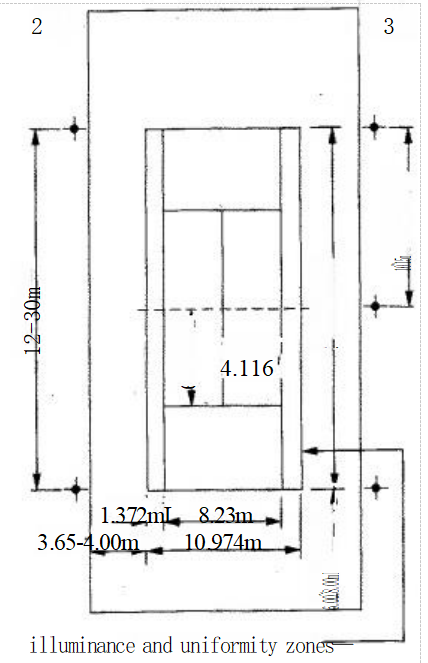
c. If obstacles like awnings obstruct the stands, it is necessary to reposition the light poles further back to maintain lighting quality. The distance of the light pole from the venue correlates with its height; the greater the distance, the taller the pole needs to be. Figure 3 illustrates this relationship.
Fig. 3 Relationship between the light pole height and its distance from the tennis court.
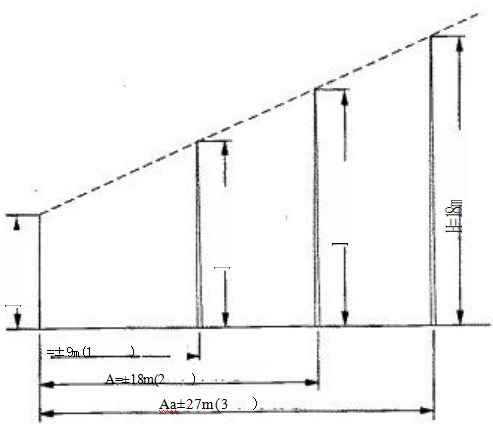
4. Tennis Court Lighting Calculation
Flood lights are commonly utilized in contemporary sports. Their beam angles typically range from 20° to 180°. Different sports require flood lights with varying beam diffusion angles, and tennis courts usually employ flood lights with wide-angle light distribution curves.
There are several methods for calculating flood lighting, including the unit capacity method, the coefficient method, and the point-by-point calculation method. The utilization coefficient method is primarily used to determine the number of lamps needed for flood lighting when the area to be illuminated, the average required illumination, and the luminous characteristics of the light source are known. The unit capacity method is a simplified version of the utilization coefficient method, offering lower accuracy and is generally suitable for preliminary designs or areas with minimal lighting needs. The point-by-point calculation method is the most precise approach for flood lighting calculations, providing details on illumination distribution, average illumination, uniformity, gradient, and necessary vertical or inclined illumination values. However, this method is complex and typically requires computer software for lighting calculations, making it the preferred method for technical and construction design.
4.1 Utilization Coefficient Method
When the area of the illuminated surface, the average illuminance required, and the luminous parameters of the light source are known, the number of lamps needed for flood lighting can be calculated using the following formula:

Where: Ea—average illuminance value needed on the illuminated surface, Ix; A—area of the illuminated surface in square meters (m²); Φ—luminous flux from the light source in each flood light, measured in lumens (lm); ηa—effective efficiency of the flood light; U—utilization coefficient of the effective luminous flux of the flood light; MF—maintenance factor.
4.2 Point-by-point calculation method
Floodlight illuminators possess unique characteristics that set them apart from standard point light sources. In typical point light sources, the optical axis is vertical, whereas in flood light illuminators, the optical axis is angled downwards at an angle γ relative to the horizontal plane.
For projectors with asymmetric light distribution, the light intensity in the desired direction is typically determined by its vertical angle θ and horizontal angle φ, with the light intensity value I derived from the equal light intensity curve. If the projector has symmetrical light distribution, the task simplifies to determining the angle α between the illuminated point's direction and the optical axis, with the light intensity Iα in that direction obtained from α using the rectangular coordinate light distribution curve of the projector.
Assuming the projector is installed at a height H, with a depression angle γ, and the distance from the projector to the illuminated point P is l, the light intensity of the projector directed at the illuminated point is Io (for symmetrical light distribution, this can be represented as I).
Taking the projection of the projector's light center onto the horizontal plane as the origin, and the projection direction of its optical axis onto the horizontal plane as the Y-axis, we establish rectangular coordinates, as illustrated in Figure 4.
Fig.4 Analysis chart for direct projection of the projector
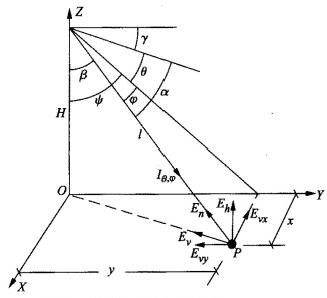
The illumination En at the plane directed by the illuminated point is calculated as follows:

According to the cosine theorem, the illumination Eh at the horizontal plane can be determined as:

The illumination at the vertical plane is calculated as:
